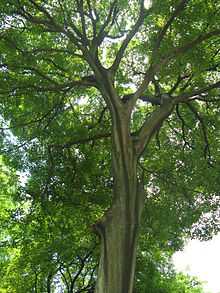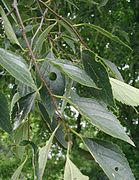Celtis
| Celtis | |
|---|---|
 | |
| Chinese Hackberry (C. sinensis) leaves and fruit | |
| Scientific classification | |
| Kingdom: | Plantae |
| (unranked): | Angiosperms |
| (unranked): | Eudicots |
| (unranked): | Rosids |
| Order: | Rosales |
| Family: | Cannabaceae |
| Genus: | Celtis L. |
| Species | |
|
Some 60-70 (see about 35 below) | |
Celtis, commonly known as hackberries, is a genus of about 60-70 species of deciduous trees widespread in warm temperate regions of the Northern Hemisphere, in southern Europe, southern and eastern Asia, and southern and central North America, south to central Africa, and northern and central South America. The genus is present in the fossil record at least since the Miocene of Europe.[1]
Previously included either in the elm family (Ulmaceae) or a separate family, Celtidaceae, the APG III system places Celtis in an expanded hemp family (Cannabaceae).[2][3]
The generic name originated in Latin and was applied by Pliny the Elder (23-79) to the unrelated Ziziphus lotus.[4]
Description

Celtis species are generally medium-sized trees, reaching 10–25 m (33–82 ft) tall, rarely up to 40 m (130 ft) tall. The leaves are alternate, simple, 3–15 cm (1.2–5.9 in) long, ovate-acuminate, and evenly serrated margins.
Small monoecious flowers appear in early spring while the leaves are still developing. Male flowers are longer and fuzzy. Female flowers are greenish and more rounded.
The fruit is a small drupe 6–10 mm (0.24–0.39 in) in diameter, edible in many species, with a dryish but sweet, sugary consistency, reminiscent of a date.
Selected species
- Celtis africana Burm.f. – White Stinkwood
- Celtis australis L. – European Hackberry, European Nettle Tree or Lote tree
- Celtis balansae Planch. (NEW CALEDONIA (AUSTRALIA))
- Celtis biondii
- Celtis brasiliensis Planch.
- Celtis bungeana L. – Bunge's Hackberry
- Celtis caucasica L. – Caucasian Hackberry
- Celtis conferta
- Celtis conferta subsp. conferta – New Caledonia
- Celtis conferta subsp. amblyphylla – Lord Howe Island
- Celtis durandii Engl.
[ syn. C. gomphophylla Bak. ] - Celtis ehrenbergiana (Klotzsch) Liebm. – Spiny Hackberry, granjeno (Spanish) (SOUTHERN US, MEXICO, GREATER ANTILLES, NORTHERN SOUTH AMERICA)
- Celtis hypoleuca Planch. (NEW CALEDONIA (AUSTRALIA))
- Celtis iguanaea (Jacq.) Sarg. – Iguana Hackberry (FLORIDA (USA), MEXICO, CARIBBEAN, C and SOUTH AMERICA)
- Celtis integrifolia L. – African Hackberry
- Celtis jessoensis Koidz. – Japanese Hackberry (JAPAN, KOREA)
- Celtis koraiensis L. – Korean Hackberry
- Celtis labilis L. – Hubei Hackberry
- Celtis laevigata Willd. – Southern Hackberry or Sugar Hackberry, (SOUTHERN US / TEXAS) Sugarberry (E USA, NE MEXICO)
- Celtis lindheimeri Engelm. ex K.Koch – Lindheimer's Hackberry (TEXAS (USA), COAHUILA (MEXICO))
- Celtis loxensis
- Celtis luzonica Warb. (PHILIPPINES)
- Celtis mildbraedii Engl.
- Celtis occidentalis L. – Common Hackberry, Northern Hackberry, False Elm (E NORTH AMERICA)
- Celtis pallida – Desert Hackberry, Shiny Hackberry (SOUTHWESTERN US / TEXAS, N MEXICO)
- Celtis paniculata (Endl.) Planch. (E MALESIA, E AUSTRALIA, MICRONESIA, W POLYNESIA)
- Celtis philippensis Planch.
- Celtis planchoniana, eastern Europe and western Asia
- Celtis reticulata Torr. – Netleaf Hackberry (W North America)
- Celtis schippii
- Celtis sinensis Pers. – Chinese hackberry, Chinese nettle-tree or Japanese hackberry (CHINA, JAPAN)
[ syn. C. japonica Planch.; C. sinensis var. japonica (Planch.) Nakai; C. tetrandra ssp. sinensis (Roxb.) Y.C.Tang ] - Celtis tala Gillet ex Planch. – Tala (SOUTH AMERICA)
- Celtis tenuifolia Nutt. – Dwarf Hackberry (E NORTH AMERICA)
- Celtis tetranda Roxb.
- Celtis timorensis Span.
- Celtis tournefortii L. – Oriental Hackberry
- Celtis triflora
- Celtis trinervia
- additional list source
Formerly placed here
- Trema cannabina Lour. (as C. amboinensis Willd.)
- Trema lamarckiana (Schult.) Blume (as C. lamarckiana Schult.)
- Trema orientalis (L.) Blume (as C. guineensis Schumach. or C. orientalis L.)
- Trema tomentosa (Roxb.) H.Hara (as C. aspera Brongn. or C. tomentosa Roxb.)[7]
Uses and ecology
Several species are grown as ornamental trees, valued for their drought tolerance. They are a regular feature of arboreta and botanical gardens, particularly in North America. Chinese Hackberry (C. sinensis) is suited for bonsai culture, while a magnificent specimen in Daegu-myeon is one of the natural monuments of South Korea. Some, including Common Hackberry (C. occidentalis) and C. brasiliensis, are honey plants and pollen source for honeybees of lesser importance. Hackberry wood is sometimes used in cabinetry and woodworking.
The berries are often eaten locally. The Korean tea gamro cha (감로차, 甘露茶) contains C. sinensis leaves.
Lepidoptera
Celtis species are used as foodplants by the caterpillars of certain Lepidoptera. These include mainly brush-footed butterflies, most importantly the distinct genus Libythea (beak butterflies) and some Apaturinae (emperor butterflies):

- Acytolepis puspa (Common Hedge Blue) – recorded on Chinese Hackberry (C. sinensis)
- Automeris io (Io Moth) – recorded on Southern Hackberry (C. laevigata)
- Asterocampa celtis (Hackberry Butterfly, Hackberry Emperor)
- A putative new taxon of the Two-barred Flasher (Astraptes fulgerator) cryptic species complex, provisionally called "CELT", has hitherto only been found on Celtis iguanaea.[8]
- Libythea celtis (European Beak)
- Libythea labdaca (African Beak)
- Libythea lepita (Common Beak)
- Libythea myrrha (Club Beak) – recorded on C. tetranda
- Nymphalis xanthomelas (Scarce Tortoiseshell) – recorded on European Hackberry (C. australis)
- Sasakia charonda (Great Purple Emperor) – recorded on Japanese Hackberry (C. jessoensis) and Pseudo-hackberry (C. japonica)
Pathogens
The plant pathogenic basidiomycete fungus Perenniporia celtis was first described from a Celtis hostplant. Some species of Celtis are threatened by habitat destruction.
Gallery
-

Celtis aetnensis with mature fruit
-
Caucasian Hackberry (Celtis caucasica) with immature fruit
-

African Hackberry (Celtis integrifolia)
-

Chinese Hackberry (Celtis sinensis)
Footnotes
- ↑ Keeler (1900): pp.249-252
- ↑ Stevens, P.F., Angiosperm Phylogeny Website : Cannabaceae
- ↑ "Celtis L.". GRIN Taxonomy for Plants. Retrieved February 12, 2012.
- ↑ Quattrocchi, Umberto (2000). CRC World Dictionary of Plant Names. I A-C. CRC Press. p. 468. ISBN 978-0-8493-2675-2.
- ↑ "Celtis ehrenbergiana (Klotzsch) Liebm.". GRIN. USDA. 2002-01-10. Retrieved April 16, 2009.
- ↑ "Celtis sinensis Pers.". GRIN. USDA. Retrieved July 2, 2009.
- ↑ "GRIN Species Records of Celtis". Germplasm Resources Information Network. United States Department of Agriculture. Retrieved 2010-12-04.
- ↑ Hébert et al. (2004), Brower et al. (2006)
References
| Wikimedia Commons has media related to Celtis. |
| Wikispecies has information related to: Celtis |
- Brower, Andrew V.Z. (2006): Problems with DNA barcodes for species delimitation: ‘ten species’ of Astraptes fulgerator reassessed (Lepidoptera: Hesperiidae). Systematics and Biodiversity 4(2): 127–132. doi:10.1017/S147720000500191X PDF fulltext
- Keeler, Harriet L. (1900): Our Native Trees and How to Identify Them. Charles Scriber's Sons, New York.
- Hébert, Paul D.N.; Penton, Erin H.; Burns, John M.; Janzen, Daniel H. & Hallwachs, Winnie (2004): Ten species in one: DNA barcoding reveals cryptic species in the semitropical skipper butterfly Astraptes fulgerator. PNAS 101(41): 14812-14817. doi:10.1073/pnas.0406166101 PDF fulltext Supporting Appendices
